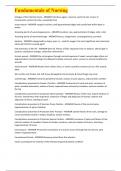Fundamentals of Nursing
6 Stages of the Infection Cycle - ANSWER-Infectious agent, reservoir, portal of exit, means of
transmission, portals of entry, susceptible host
acute wound - ANSWER-surgical incisions; well approximated edges and usually heal within days to
weeks
Assessing points of wound appearance - ANSWER-Location, size, approximation of edges, odor, color
Assessing points of wound drainage - ANSWER-Serous, sanguineous, serosanguineous, purulent
bacteria - ANSWER-categorized by shape, gram +/-, need for oxygen; the most significant and commonly
observed infection-causing agent
Characteristics of fall risk - ANSWER-Over 65, history of falls, impaired vision or balance, altered gait or
posture, medication changes, unfamiliar environment
chronic wound - ANSWER-Do not progress through normal sequence of repair; wound edges often not
approximated, normal healing time delayed; Example: pressure ulcers, venous or arterial insufficiency
wounds
closed wound - ANSWER-Results from a blow, force, or strain caused by trauma such as a fall, assault,
MVA
Skin surface not broken, but soft tissue damaged & internal injury & hemorrhage may occur
cold therapy - ANSWER-Constricts peripheral vessels, reduces muscle spasms, and promotes comfort
Complications prevented in Fowler's Position - ANSWER-Contracture of neck and wrist, curvature of
spine, shoulder dislocation, edema of hand, impaired lower extremity circulation, external rotation of
the hip
Complications prevented in protective lateral position - ANSWER-flexion of the neck, inward rotation of
the arm, interference with respiration, extension of finger and abduction of thumb, rotation and
adduction of femur, twisting of spine
Complications prevented in Protective Prone Position - ANSWER-Flexion of the cervical spine,
hyperextension of spine, footdrop
Complications prevented in Protective Sims' Position - ANSWER-Lateral flexion of the neck, damage to
nerves and blood vessels in axillae, footdrop, lumbar lordosis,
Complications prevented in Protective Supine Position - ANSWER-curvature of spine and flexion of hip,
internal rotation of shoulders, flexion of lumbar curvature, external rotation of femurs, foot drop,
hyperextension of knees
Contractures - ANSWER-Permanent contraction of a muscle; occurs through lack of exercise, joint
motion, & good posture
Convalescent Period - ANSWER-Recovery period from the infection
Varies according to the severity of the infection & general patient condition
, Fundamentals of Nursing
D.A.M.E - ANSWER-*D*rug and alcohol use
*A*ge related physiologic status
*M*edical Problems
*E*nvironment
Define body mechanics. - ANSWER-The use of proper body positions to provide protection from the
stress of movement and activity.
Describe Pneumatic Compression Devices and their usage. - ANSWER-Composed of air pump,
connecting tubes, & extremity sleeves that apply intermittent or sequential pressure to the legs to
enhance blood flow and venous return, stimulating the normal muscle-pumping action in the legs
endogenous infection - ANSWER-The causative organism comes from microbial life harbored in the
person
Eschar - ANSWER-Thick leathery scab or dry crust that is necrotic and must be removed before
determining stage
exogenous infection - ANSWER-The causative organism is acquired from other people
Explain how compression stockings work. - ANSWER-By applying pressure, these increase the velocity of
blood flow in superficial and deep veins, and venous function in legs
Fowler's Position - ANSWER-
Full Stage of Illness - ANSWER-Presence of specific signs/symptoms; Localized symptoms versus systemic
symptoms
Fungi - ANSWER-Molds and yeasts; parasitic organism
general anesthesia - ANSWER-Administer drugs via inhalation or IV to produce central nervous system
depression
Desired Actions: loss of consciousness, analgesia, relaxed skeletal muscles, & depressed reflexes
Guidelines for foot care - ANSWER-Bathing feet without soaking, rinse, dry thoroughly, apply
moisturizer, file diabetic patient nails, never cut off corns or calluses, appropriate footware
heat therapy - ANSWER-Dilates peripheral blood vessels, increases tissue metabolism, reduces blood
viscosity & increases capillary permeability
Helps relieve pain
hemorrhage - ANSWER-complication which may occur from slipped suture, dislodged clot at wound site,
infection, or erosion of blood vessel by a foreign body such as a drain
hemostasis - ANSWER-Occurs immediately after the initial injury when blood vessels constrict & blood
clotting begins through platelet activation & clustering then the vessels dilate allowing plasma & blood
components leak into injured area, forming exudate.




